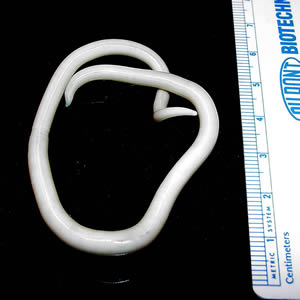Helminths are worm-like parasites. Depending on where you live, you probably don’t hear about helminth infections very often. Bacteria or virus infections edge out the helminths for most peoples’ understanding of the causes of infectious disease.
Yet, helminths are an interesting and riveting group of organisms. They are invertebrates and are worm-like, characterized by flat or rounded bodies. They have very different characteristics according to type and have very different hosts and life cycles. Hosts and life cycles can play a major role in trying to prevent infectious diseases caused by helminths.
This lesson will concentrate on the helminths that cause infectious disease in humans.
Objectives
To understand the importance of helminths and their role in causing infectious disease, you should be able to:
- Describe the characteristics of three groups of helminths.
- Identify examples of helminths that cause disease.
- Describe how helminth life cycles impact the epidemiological prevention and control measures.
Vocabulary
- Cestoda—the class to which the tapeworms belong
- definitive host—the host that harbors the adult stage of a parasite
- helminth—worm-like parasites
- hermaphroditic—having both male and female reproductive organs in the same individual
- larval stage—an immature stage in a life cycle between the egg and the adult
- Nematoda—the phylum to which the round worms belong
- parasite—an organism that lives in or on a host organism for at least part of its life cycle
- proglottid—segments of a tapeworm body
- scolex—head of a flatworm
- Trematoda—class to which the flukes belong
There are two major groups of helminths: the flatworms (flukes and tapeworms) and the roundworms. Both groups have members which are parasitic. Flatworms belong to the phylum Platyhelminthes; roundworms belong to the phylum Nematoda.
While host defenses can eliminate some helminth infections, some types of infections can last for years as the helminths successfully avoid immune responses. Because the worms can migrate through the body, they can damage a variety of host organs disrupting function, laying their eggs, and continuing the life cycle when they exit the body.
Helminths have egg, larva, and adult states. The epidemiology of prevention and control of infectious helminth diseases relies on an understanding of the growth and development of various helminth life stages. Transmission during life stages, proper diagnosis of the disease, treatment of patients having the parasites, and prevention and control of the disease are affected by features of the parasite and its very specific life cycle.
Since helminth life cycles usually have multiple hosts, one means of effective prevention involves eliminating intermediate hosts from the environment; the absence of the specific intermediate host can disrupt the parasite’s life cycle. Other prevention measures rely on good hygiene practices. Many parasites are spread due to poor hygiene and contaminated water and food supplies.
For infectious disease consideration, the three main types of helminths are the flukes (trematodes), the tapeworms (cestodes), and the roundworms (nematodes).
Flukes (Class Trematoda)
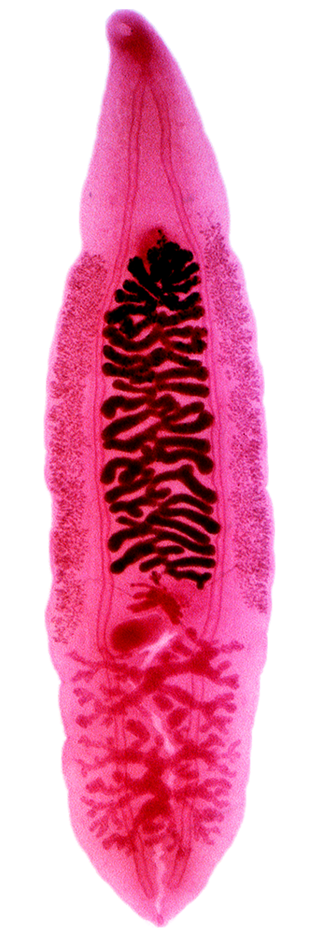
Liver fluke Clonorchis sinensis
Image Source: Wikiwand
Flukes are parasitic worms having complex life cycles. They usually have sexual stages, many asexual stages, and one to four hosts.
Flukes have a leaf-shaped appearance and range in length from several millimeters to 8 centimeters. As an example, the adult Chinese liver fluke shown at left, lives in the human liver, the bile duct, and the gall bladder. These flukes infect about 30 million people; most are found in China, Korea, Vietnam, and Russia.
Note the flattened body, bilateral symmetry, definite anterior and posterior tapered ends, and the anterior sucker. These are characteristic of this group of parasites.
Flukes have a well-developed digestive tract with a muscular pharynx and esophagus. An excretory vesicle receives material from two collecting ducts.
Except for the blood flukes, trematodes are hermaphroditic (having both male and female sex organs in the same organism). Male sex organs are testes; the female sex organ is an ovary. Eggs pass through a uterus to be expelled through the genital pore.
Blood flukes have separate sexes and are the separate-sex flukes to infect humans. In the final host, adult blood flukes live in close proximity in the lumen (opening) of blood vessels.
Flukes have very specific life cycles; intermediate and final hosts are specific to exact genus/species or the organism cannot progress through its life cycle. In general, life cycle stages occur when eggs are passed in the feces, urine, or sputum of humans into a water environment. Eggs hatch in the larval form when are eaten by an intermediate host. A sporocyst develops within the intermediate host. The sporocyst matures and migrates out of the intermediate host into a (usually) water environment. From this stage, the form either infects a definitive host (a host that harbors the adult form of a parasite) or develops directly into an immature adult form which later enters a definitive host.
Symptoms of trematode infections depend on the specific trematode infecting the victim. Symptoms range from respiratory difficulty to fevers, chills, night sweats, headaches, heart palpitations, rashes, diarrhea, vomiting, abdominal pain, chest pain, and neurological problems if the fluke infects the brain.
Trematode Infectious Disease Examples
Liver Fluke
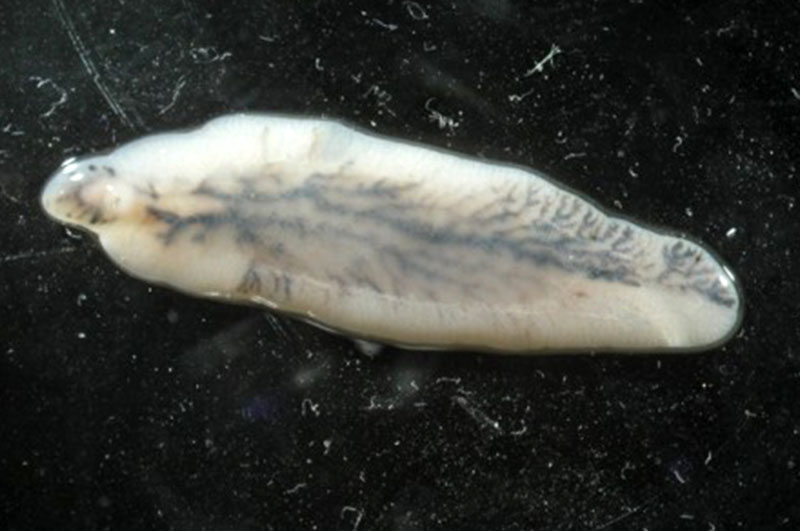
Fasciola hepatica.
Image Source: Wikipedia
Liver flukes feed on the blood of their hosts. They reside in the liver, bile ducts, and gallbladder. Fasciola hepatica is one of the largest flukes in the world and can reach a length and width of 30 x 13 mm.
Liver flukes are not passed directly from one person to another; eggs are passed in the stool of an infected person and need an intermediate host for complete development.
Symptoms of human liver fluke infections include fever, an enlarged liver, abdominal pain, anorexia, nausea, and vomiting and can start months after the initial exposure.
Diagnosis is confirmed by the presence of Fasciola eggs in stool specimens.
Blood Fluke
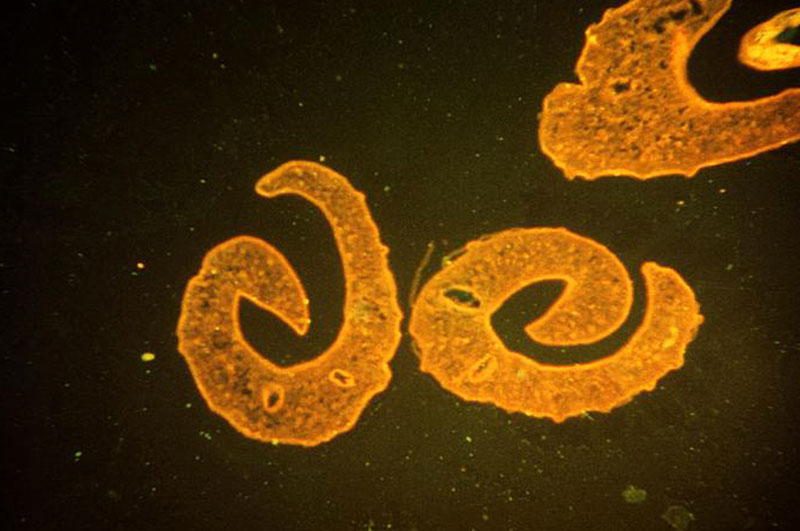
Schistosoma mansoni.
Content provider: CDC/Marianna Wilson
Image Source: phil.cdc.gov
Schistosomiasis, an infection by a blood fluke belonging to the Schistosoma genus, is one of the most devastating parasitic diseases, second only to malaria (caused by the protozoan Plasmodium sp.) It is common in areas with poor sanitation.
Children are particularly susceptible because Schistosoma are often in water that is used for swimming and bathing.
Symptoms include a rash, fever, chills, cough, and muscle aches. If untreated, chronic infections can result with symptoms of abdominal pain, enlarged liver, bloody stool and urine, and increased risk of bladder cancer. If eggs from adult worms travel to the brain or spinal cord, seizures and paralysis can result.
Lung Fluke
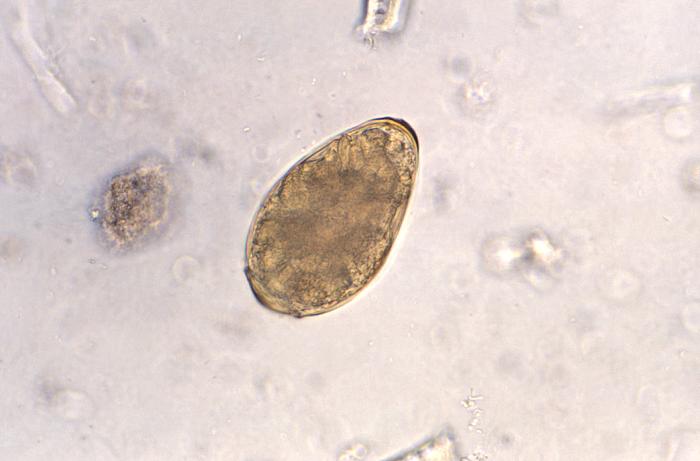
Paragonimus westermani egg.
Content provider: CDC/Dr. Mae Melvin Image source: phil.cdc.gov/phil
There are a number of species that cause lung fluke disease. All belong to the genus Paragonimus and are common parasites of mammals that eat crustaceans such as crabs and crayfish (the intermediate hosts).
Humans ingest lung flukes when they eat infected crustaceans. As worms mature, immature forms travel to the lungs and result in chronic coughs, bloody sputum, chest pain, fever, and pneumothorax (collapsed lung). If immature worms migrate to the brain instead, severe disease with headache, visual impairment and epileptic seizures can result.
Tapeworms (Cestodes)
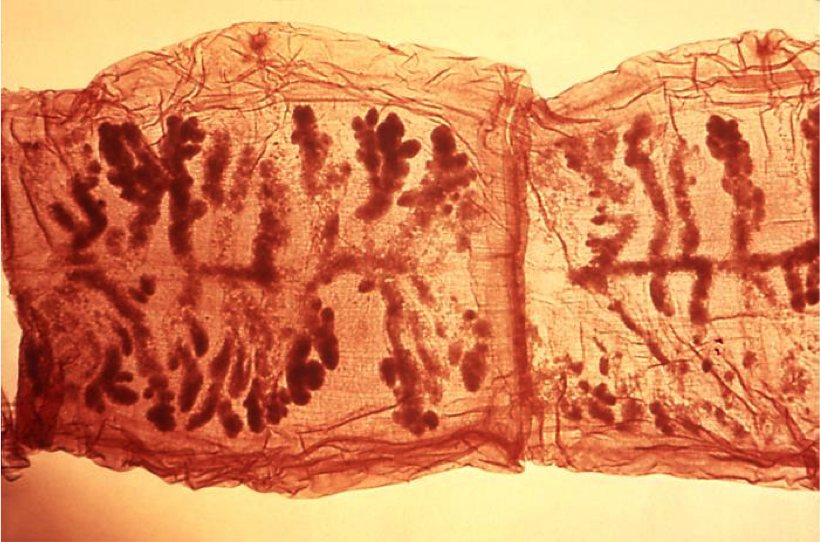
Anatomy of a tapeworm proglottid.
Image Source: phil.cdc.gov
All 3,400 types of tapeworms are parasitic. They have no mouths or intestines; their skin absorbs nutrients from the host.
Tapeworms are flat and long. Three body sections include the scolex, the neck, and the strobila. The scolex has suckers and hooks, except for T. saginata which lacks hooks. The strobila is made up of a chain of segments called proglottids. Each proglottid has both male and female reproductive organs. Reproduction is by self-fertilization, but egg release differs according to tapeworm species. In some species eggs exit through a uterine pore while in other species, egg-containing proglottids are shed directly into the host intestines.
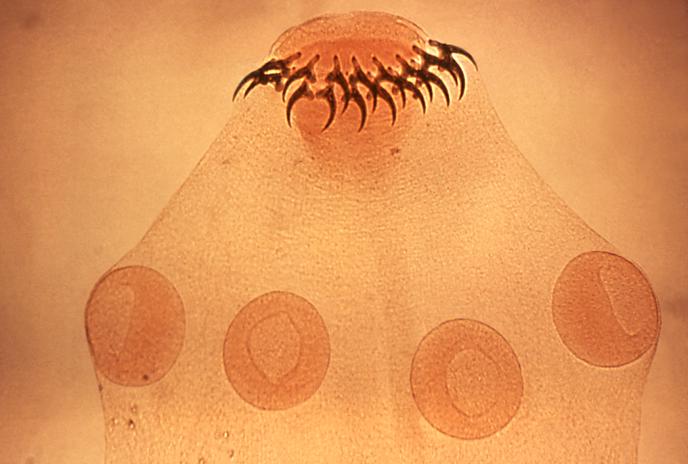
Scolex of Taenia solium, a pork tapeworm.
Image Source: Wikipedia
The scolex contains cephalic ganglion, nerve tissue that makes up the tapeworms, nervous system. A parasitic worm’s scolex attaches to the intestine of the host with hooks and suckers. The number of hooks and suckers is one way to identify the type of worm, but since it is inside the host, diagnosis is usually by identifying the eggs and shed body segments in the host’s feces.
Adult tapeworms have no digestive tract, mouth, or anus. It absorbs its nutrients from the predigested food in the host’s intestines directly through the skin.
Typically, tapeworm infections cause few symptoms. Severe infections can result in symptoms such as nausea, weakness, diarrhea, abdominal pain, loss of appetite, weight loss and fatigue.
Types of Tapeworms
Beef Tapeworm
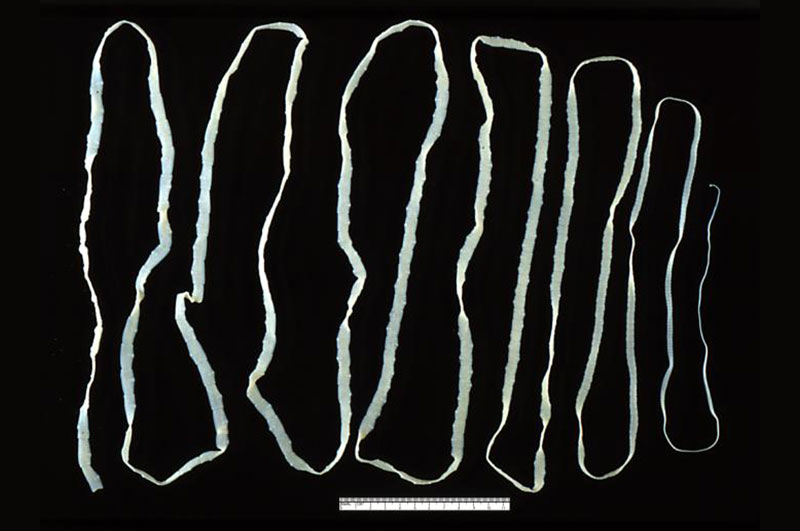
Taenia saginata, beef tapeworm
Image Source: Wikipedia
Taenia saginata, the beef tapeworm, is the largest Taenia tapeworm. An adult worm is an average of 4-10 meters long, but can become much longer. People are infected with T. saginata by eating raw or undercooked beef infected with the tapeworm.
PORK TAPEWORM
The head of Taenia solium.
Image Source: Wikipedia
Taenia solium, the pork tapeworm Typical of tapeworms, T. solium has a flat, segmented body. It measures from 2-3 meters in length. The scolex has 4 suckers that attach the tapeworm to the intestinal wall. It is transmitted to humans, the definite host, when undercooked pork is consumed. Pigs, the intermediate host, eat the eggs of the tapeworm and the eggs develop into larva.
Roundworms
As the name implies, roundworms have a cylindrical body. The body is tapered at both ends and covered with a thick cuticle. A round worm is the simplest animal to have a complete digestive system, from mouth to anus.
Roundworms have separate sexes; males are usually smaller than females.
Most roundworms are free-living and play an important role in recycling nutrients in nature. Thousands of roundworms may inhabit a handful of topsoil. But, parasitic roundworms can cause severe illness in humans.
Types of Roundworms
Pinworms

Enterobius vermicularis, pinworm. Image source: Wikipedia
Parasitic roundworms called pinworms live in host intestines, but at night female pinworms migrate to the anal region to lay eggs, causing itching. When the host scratches, pinworm eggs are transferred to the hands and then outside the body to other objects. If another human ingests the eggs, the cycle starts again.
Pinworms are spread from person-to-person, by touching infected bedding, food, or other objects contaminated with pinworm eggs.
Symptoms include intense itching, difficulty sleeping, infected anal areas due to scratching, loss of appetite, and weight loss.
Hook Worms
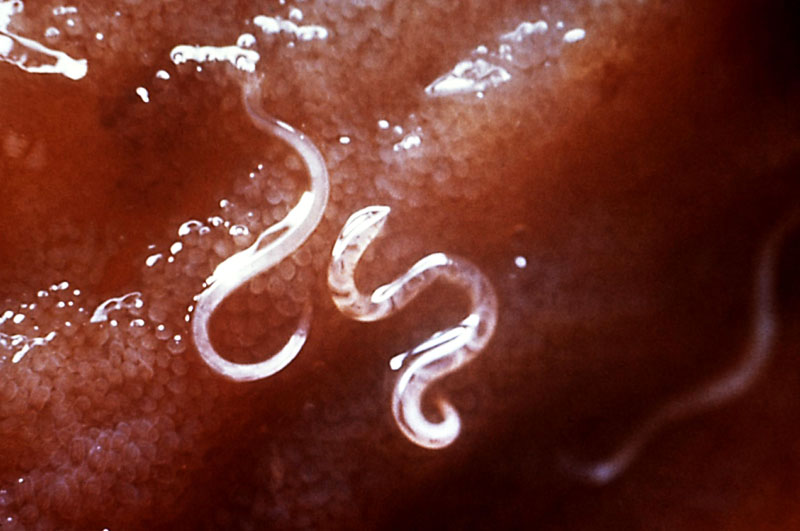
Hookworm, a parasitic blood-sucking roundworm.
Image source: Wikipedia
Hookworms attach themselves to a host’s intestines using hook-like structures on their heads. They cut into the intestinal wall and feed on host blood and tissues. Adult females can release a thousand eggs a day which leave the body in feces. The eggs hatch, releasing juvenile hookworms. When juveniles come into contact with bare skin of another host, they cut their way inside and travel through the bloodstream to the lungs and up through the windpipe. When the host swallows them, they travel to the intestines and can live there for several years.
Hookworm infections affect millions of people worldwide and are a leading cause of mother and child disease in developing tropical countries. Even in developed countries, hookworm infections can lead to anemia when worms suck too much blood from the host’s intestinal walls.
Onchocerca
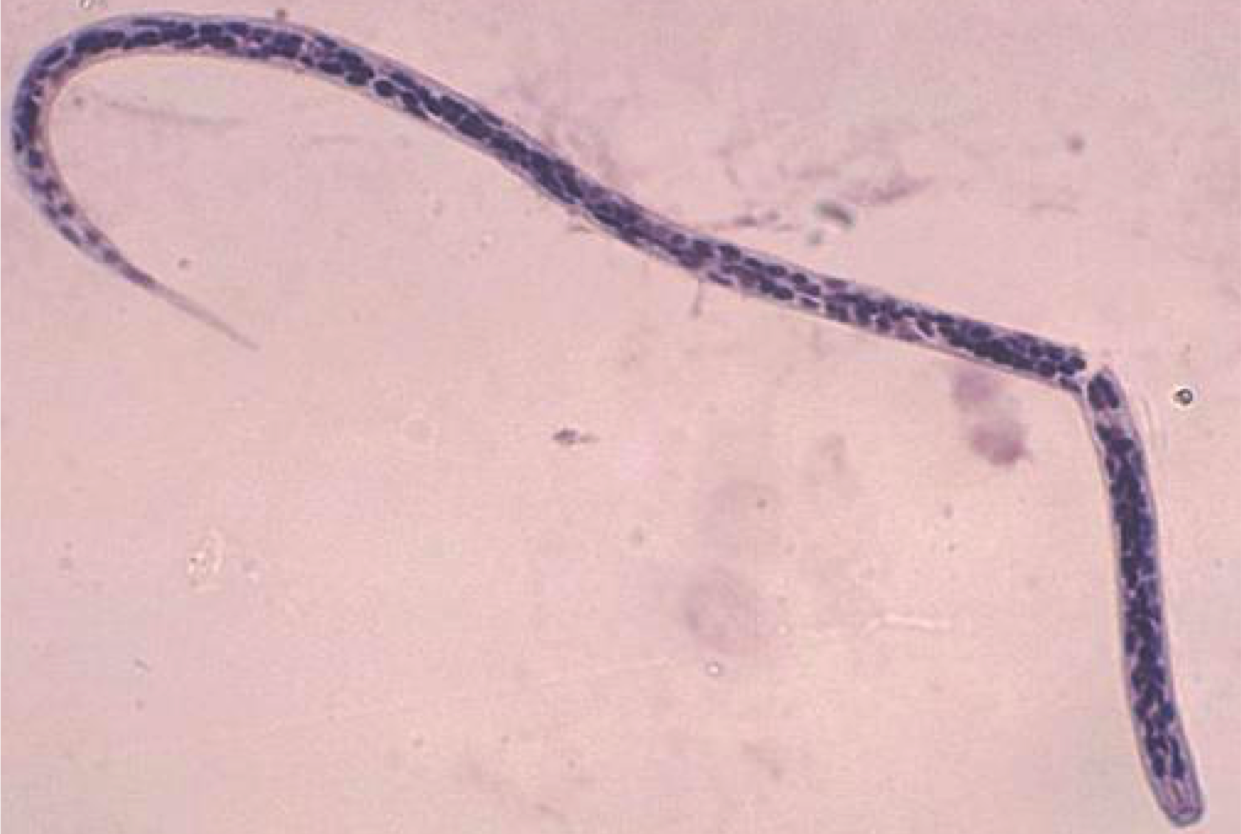
Onchocerca volculus larvae
Content provider: CDC/Dr. Lee Moore Image source: phil.cdc.gov
Infection by Onchoceriasis volvulus, a parasitic roundworm, is spread through the bite of a black fly. The common name for the disease is river blindness.
When black flies infected with Onchocerca sp. feed on humans, they inject immature worms under the skin causing intense itching and rashes. The immature worms migrate and can enter the eyes causing blindness. Victims also have a skin discoloration, known as “leopard skin” and intense itching results when some of the immature worms die under the skin.
Onchocerca worms can live in a human for 10-15 years and female worms can reproduce millions of worms in a lifetime. Adult female worms can be more than one-half meter long.
Check Your Understanding
- Describe the body plan and structure of a flatworm.
- How does the digestive tract of flatworms differ from the digestive tract of round worms? What advantage, if any, does this give roundworms?
- Name 3 types of parasitic flukes and describe the diseases they cause. What is the definitive host in all three types of fluke infections?
- Describe ways of preventing and controlling parasitic worm infections based on how they are transmitted and the characteristics of their life cycles.
- Critical thinking: Many groups of parasitic worms are hermaphroditic. How is being hermaphroditic an advantage for an organism?

